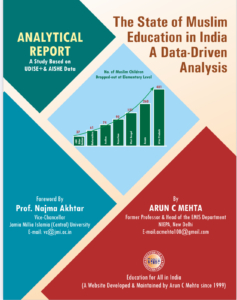Enrolment Crisis: Why School Enrolment Hit a 7-Year Low in UDISE+ 2024-25
Enrolment Crisis: Why School Enrolment Hit a 7-Year Low in UDISE+ 2024-25
Introduction
India’s commitment to universal school education, enshrined in the Right to Education (RTE) Act 2009, faces a critical challenge as the Unified District Information System for Education Plus (UDISE+) 2024-25 report, released on August 28, 2025, reveals a sharp decline in enrolment. Total enrolment across Classes 1-12 has fallen to 232.89 million – a drop of 2.08 million from 234.97 million in 2023-24, marking the lowest level since 2017-18’s 250.99 million. Over seven years, enrolment has contracted by 16.03 million (6.4%), with primary levels (Classes 1-5) declining by 17.46 million since 2021-22. During 2023-24 to 2024-25, primary enrolment declined by 3.5 million (3.21%) and that of elementary level (classes 1 to 8) by 2.89 million but upper primary enrolment increased by 0.57 million (0.90%)
As a pioneer in developing India’s Educational Management Information System (EMIS) and UDISE, analysis of Prof. Arun C Mehta, hosted on Education for All in India, frames this “enrolment crisis” as a convergence of demographic transitions, enhanced data accuracy, and post-COVID reversals. Despite progress in dropout rates and infrastructure under Samagra Shiksha, this decline threatens the National Education Policy (NEP) 2020’s goal of 100% Gross Enrolment Ratio (GER) by 2030. This post, supported by a chart and table, dissects trends, causes, regional variations, and policy imperatives to steer India toward universal schooling.
The Alarming Data: A Seven-Year Downward Trajectory
The UDISE+ 2024-25 report, covering 14.71 lakh schools, confirms a persistent enrolment decline since the 2021-22 peak of 255.74 million. Primary enrolment (Classes 1-5) fell to 104.38 million, down 3.46 million from 2023-24 and 17.46 million (14.33%) since 2021-22. Upper primary (Classes 6-8) and secondary (Classes 9-12) stages saw modest gains, but foundational levels – central to NEP 2020’s early childhood focus – face severe contraction.
The table below, sourced from UDISE+ data and analysis presented on educationforallinindia.com, illustrates the 7-year trend:
| Year | Total Enrolment (Million) | Primary Enrolment (Million) | Change from Previous Year (Million) | GER – Elementary (%) |
|---|---|---|---|---|
| 2017-18 | 250.99 | 121.84 | – | 93.2 |
| 2018-19 | 248.87 | 120.50 | -2.12 | 92.8 |
| 2019-20 | 246.12 | 118.92 | -2.75 | 92.1 |
| 2021-22 | 255.74 | 121.84 | +9.62 | 109.66 |
| 2022-23 | 241.62 | 112,42 | -7.42 | 99.6 |
| 2023-24 | 234.97 | 107.84 | -8.92 | 96.3 |
| 2024-25 | 232.89 | 104.38 | -2.08 | 90.6 |
The chart below visualizes these trends, highlighting the post-2021 reversal:
The table and chart, aligned with UDISE+ data, show a temporary 2021-22 spike (post-COVID government school influx) followed by steep declines. GER at elementary levels stagnated at 90.6% in 2024-25, down from 93.0% primary GER in 2023-24 to 90.9%. Dropout rates improved – primary at 0.8% (from 1.9%), upper primary at 4.1% (from 5.2%), and secondary at 13.3% (from 14.1%) – but absolute dropouts remain high at 4.27 million in secondary. Retention rates rose to 92.4% at primary but fell to 62.9% at secondary, signalling transition bottlenecks.
Unravelling the Causes: Demographics, Data Refinements, and Systemic Shifts
The enrolment decline, as detailed in my UDISE+ 2024-25 analysis, stems from multiple factors:
- Demographic Transition: India’s total fertility rate (TFR) has dropped to 2.0, reducing the school-age cohort (6-14 years) by 1-2% annually. This is evident in a 25-lakh drop in ages 3-11 enrolment (from 120.90 million to 118.41 million).
- Data Accuracy: UDISE+ enhancements since 2022-23, including 89.4% Aadhaar seeding and student-level tracking, eliminated duplicates, accounting for part of the 2022-23 drop (14.12 million). The 2024-25 decline of 2.08 million reflects genuine losses, as verified in previous computations.
- Post-COVID Reversal: Lockdowns drove temporary government school enrolment surges, but post-recovery, families shifted to private unaided schools (up 4.82 million to 85.70 million, 36.8% share). Government schools, comprising 69% of institutions, hold only 50.83% enrolment (118.38 million, down 22.12 million from 2021-22).
- School Closures: Since 2017-18, 87,430 schools (mostly government) closed, with 20.6% of schools now having fewer than 30 students. Budget constraints (3.5% of GDP) exacerbate access issues, especially in rural areas.
- Quality Perceptions: Learning deficits – 40% of Class III unable to read short stories (ASER) – and inconsistent PM-POSHAN coverage (e.g., Delhi at 60-69%) deter retention. Marginalized groups (SC/ST/OBC enrolment down over 8 lakh) are shifting to private options or home-schooling.
State-Wise Variations: A Mosaic of Resilience and Vulnerability
Enrolment patterns vary across states, as detailed state-wise breakdowns on Education for All in India. High-fertility states like Bihar and Uttar Pradesh show resilience, with UP reporting zero primary dropouts but a 3% upper primary rate. Southern states like Karnataka and Tamil Nadu face declines across levels, while Odisha’s enrolment fell by 1.13 lakh alongside a reduction to 61,565 schools.
North-eastern and tribal regions, such as Ladakh (high single-teacher schools) and Assam (17.5% secondary dropout), struggle with access and high pupil-teacher ratios (PTRs >30:1). The Ministry’s directive for 23 States/UTs to submit remedial plans underscores possible gaps in PM-POSHAN implementation.
Implications for Quality Education and NEP 2020 Ambitions
The 7-year enrolment low jeopardizes NEP 2020’s goal of universal access by 2030. Shrinking cohorts strain Samagra Shiksha’s ₹37,010 crore budget, with small schools (75 thousand with <10 students) demanding mergers. Positives include girls’ enrolment at 48.4% and infrastructure gains (93.6% electrification, 63.5% internet), but rural-urban divides and learning crises (50% Class III unable to recognize shapes) persist. This risks a “lost generation” and undermines India’s skill dividend, as I’ve noted in my NEP 2020 indicator analyses.
Conclusion: A Data-Driven Path to Recovery
The UDISE+ 2024-25 enrolment crisis demands urgent action. By addressing demographic realities with targeted policies – bolstering ECCE, preventing school closures, enhancing PM-POSHAN, and raising education spending to 6% of GDP – India can reverse the decline. As chronicled on Education for All in India since 1999, UDISE+ is a roadmap for inclusive education.
Download my full UDISE+ 2024-25 analysis here for actionable strategies.




